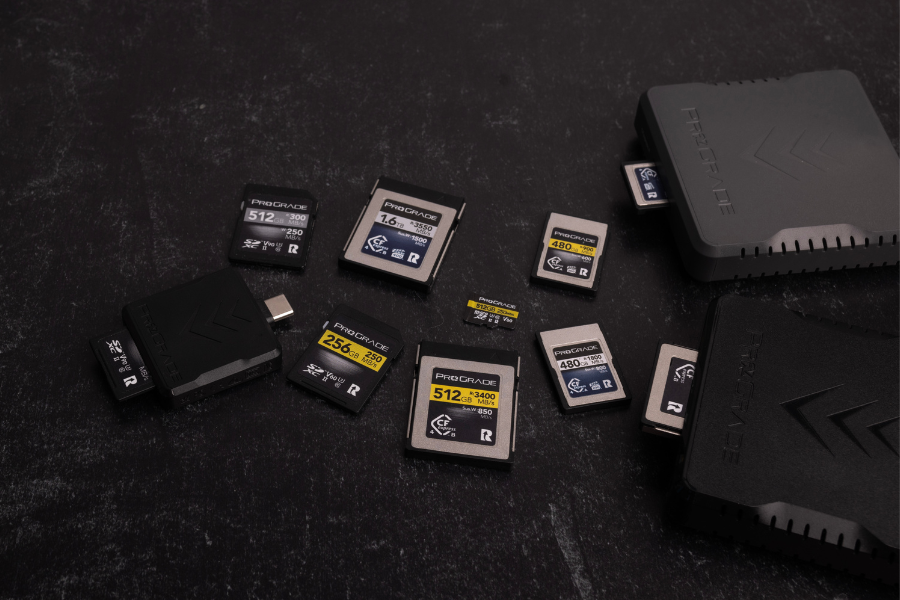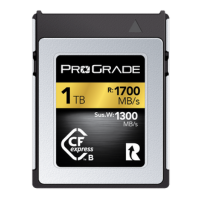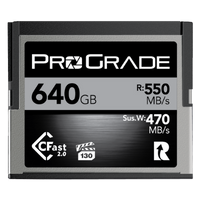Memory cards are essential components in many of our digital devices, from cameras and smartphones to gaming consoles and drones. These small, portable storage devices might seem straightforward, but understanding their speed classes is critical for anyone looking to get the most out of their technology.
Whether you’re a photographer capturing fast action shots, a videographer recording in 4K, or a gamer seeking seamless gameplay, choosing the right memory card can significantly impact your device’s performance.
Speed classes determine how quickly data can be written to or read from the card, affecting everything from the quality of your photos and videos to the responsiveness of your camera. In this article, we’ll demystify memory card speed classes and guide you in selecting the perfect card for your specific needs.
What Are Memory Card Speed Classes?
Memory card speed classes are standardized ratings that indicate the minimum sustained write speed of a memory card, measured in megabytes per second (MB/s). These ratings indicate the slowest speed at which the card can consistently write data, which is necessary for tasks that require continuous data streaming, such as video recording. Memory card speed classes help users determine which cards suit their specific needs.
Speed Class 2, 4, 6, and 10
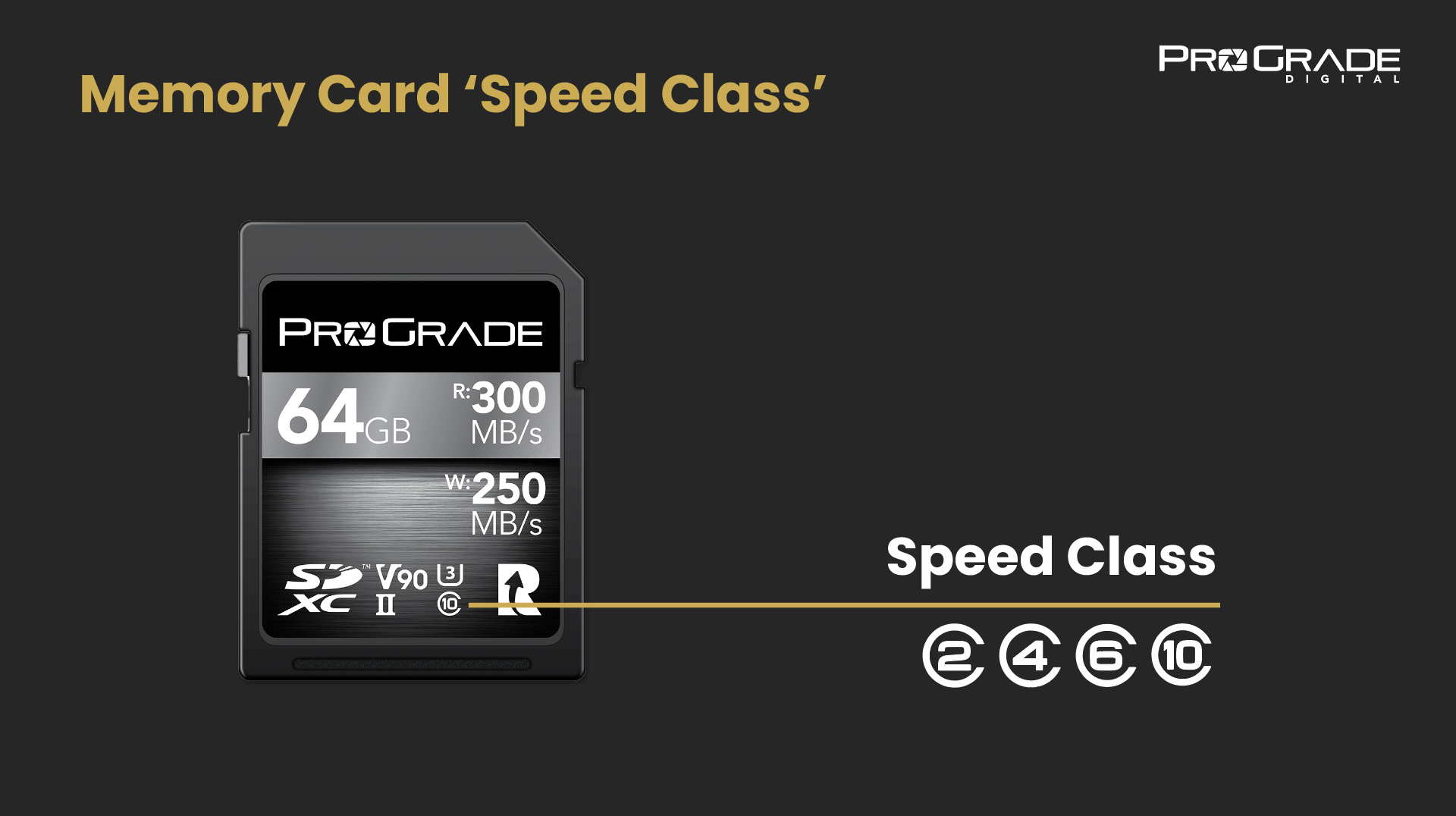
These speed classes are part of the older SD card standard. They are represented on memory cards by a number inside a “C” (e.g., C10 for Class 10). The number correlates to the minimum guaranteed write speed. For example, a Class 10 card guarantees a minimum write speed of 10 MB/s.
Speed Classes:
-
- Class 2 (C2): Minimum write speed of 2 MB/s. Suitable only for basic tasks and casual photography with older cameras.
- Class 4 (C4): Minimum write speed of 4 MB/s. Can handle lower-frame rate standard definition video recording.
- Class 6 (C6): Minimum write speed of 6 MB/s. Suitable for higher frame-rate SD video recording and low bitrate Full HD video recording.
- Class 10 (C10): Minimum write speed of 10 MB/s. Ideal for all SD video tasks and suitable for high-resolution photography.
UHS Classes (U1 and U3)
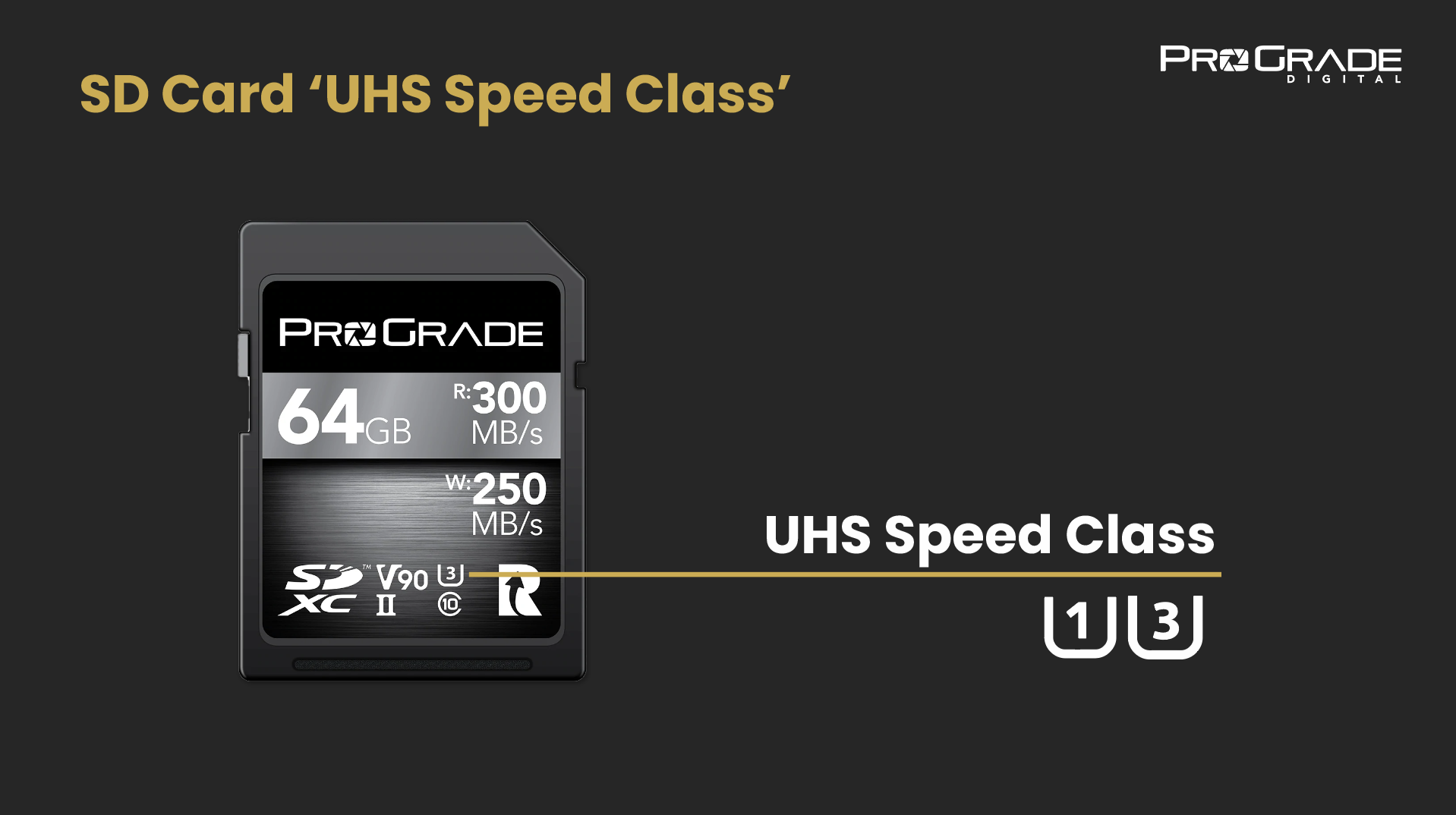
Ultra-high-speed (UHS) classes are part of a newer standard that supports higher performance levels. Indicated by a number inside a “U” (e.g., U1 or U3). The number in UHS speed classes does not directly represent the speed in megabytes per second but must be multiplied by 10 to determine the minimum write speed. For example, U3-rated cards guarantee a minimum write speed of 30 MB/s.
UHS (Ultra-High-Speed) Classes:
-
- UHS Speed Class 1 (U1): Minimum write speed of 10 MB/s. Designed for basic Full HD video recording and high-resolution photography.
- UHS Speed Class 3 (U3): Minimum write speed of 30 MB/s. Suitable for basic 4K video recording and shooting in continuous burst mode with most cameras.
Video Speed Classes (V10, V30, V60, V90)
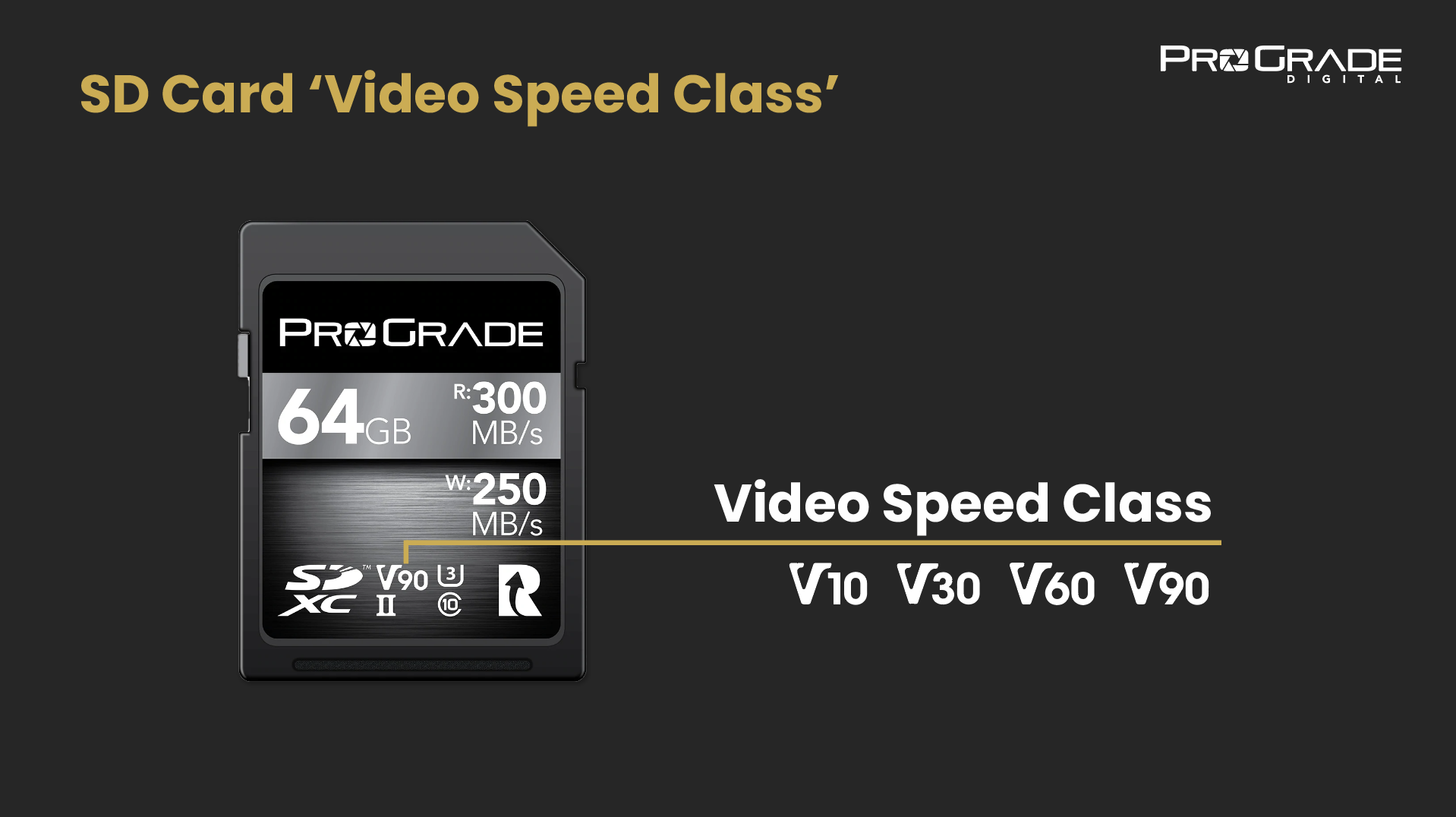
Introduced to cater to the demands of modern high-resolution video recording, these classes ensure that the card can sustain the required write speed for smooth video capture at various resolutions and frame rates. Marked on a card with a “V” followed by the number (e.g., V30, V60). The number correlates to the minimum sustained write speed in MB/s. For instance, a V30 card guarantees a minimum sustained write speed of 30 MB/s, while a V90 card guarantees a minimum write speed of 90 MB/s.
Video Speed Classes:
-
- V10: Minimum sustained write speed of 10 MB/s. Suitable for basic Full HD video recording.
- V30: Minimum sustained write speed of 30 MB/s. Ideal for high frame rate FullHD video recording and suitable for basic 4K video recording.
- V60: Minimum sustained write speed of 60 MB/s. Best for bursting RAW photos with top-grade cameras and professional-grade 4K video recording.
- V90: Minimum sustained write speed of 90 MB/s. Suitable for cinema-quality 6K video recording and other high-bitrate video tasks. Offers substantial overhead for photographers bursting RAW images.
Why Do Memory Card Speed Classes Matter?
Speed classes were created to simplify the process of choosing a memory card by providing clear, standardized performance benchmarks. This helps users quickly identify the right card for their needs without having to decode complex technical specifications frequently differing from manufacturer to manufacturer.
So, when some memory card manufacturers use questionable marketing tactics and present their memory card speeds as 633X or 1066X (which essentially compares the card’s speed to the outdated CD-ROM write speed and is not at all helpful for most users), then the standardized speed class ratings help easily determine the memory card’s actual performance capabilities.
Navigating Memory Card Speed Classes
There is some overlap between memory card speed classes because the newer, faster classes automatically meet the previous, slower class requirements. For example, a V60 card with a minimum write speed of 60 MB/s also meets the criteria for Class 2, 4, 6, and 10, as well as U1 and U3, so all memory cards rated V30 and above automatically get certified for the fastest ratings in other speed classes as well.
Why do memory card manufacturers don’t drop the older ratings and only use one, the newest standard? Some do, especially on cards with smaller form factors (microSD). However, manufacturers have not ditched older speed classes entirely because many consumer-grade applications still do not require the fastest cards, and many product manufacturers (camera makers, smartphone makers, etc.) still use older markings on their devices, websites, and packaging.
So, as long as these markings are in use, card manufacturers also continue to include them. This helps avoid confusion for consumers who may be more familiar with the older standards. For illustration, a consumer might specifically look for a Class 10 (C10) card and may not realize that a V10 or U1 card offers exactly the same performance. Keeping the older markings, therefore, makes it easier for them to find a compatible card.
For most users and those familiar with the rating system, focusing on the latest Video Speed Class rating is sufficient since it encompasses all the previous ratings and meets the requirements of modern high-performance tasks. A V60 card, for instance, can handle everything from Full HD to 4K video recording, covering the needs of Class 10 and U3 applications.
Important: All speed classes indicate the minimum sustained write speed of a memory card, and that’s it. This means that Video Speed Class-rated cards, while excellent for video recording, are not exclusively designed for that purpose; they can be used for any task requiring the specified write speed. Similarly, UHS-rated and standard Speed Class-rated cards can also be used for video recording, even though they are not specifically labeled for video use.
Pro tip: Using a card with a higher speed class than required will not affect your camera’s performance, but it ensures compatibility with a wide range of devices. At the same time, a slower card than required can impair performance, especially for demanding tasks like bursting raw images or recording 4K video. If your camera cannot store data fast enough and the buffer fills up, it starts dropping frames or stops recording altogether.
Understanding memory card speed classes ensures you choose a memory card that won’t bottleneck your device’s performance, leading to optimal results in your digital endeavors.
If you’re curious about the meaning behind all the other symbols on an SD card, check out our article: Symbols on SD Card Explained.
Choosing the Right Memory Card for Your Needs
First things first, check the requirements of your device and choose accordingly. Each device, whether a camera, smartphone, or gaming console, has specific memory card requirements that ensure optimal performance. Refer to your device’s manual or specifications to determine the recommended speed class and capacity. This will help you select a memory card that meets the minimum requirements and supports the necessary performance capabilities of your device. By starting with the device’s requirements, you can avoid compatibility issues and ensure that your memory card delivers sufficient performance for your device’s needs.
Only then consider your workflow needs and whether you should opt for faster-rated cards that speed up your workflow and are compatible with more devices. Faster cards offer versatility and are an especially smart choice if you plan to upgrade your camera or other devices in the next few years. Investing in a higher-speed card not only speeds up your workflow but also ensures you get more bang out of your cards as they meet the demands of future technology.
Photography Needs
For photographers, getting the memory card selection right is critical when dealing with high-resolution photos or burst-mode shooting. When capturing high-resolution images, the card’s write speed needs to be fast enough to keep up with the camera’s output. If you are a hobbyist, you can get away with Class 10 or U1-rated cards. For burst mode shooting, where multiple photos are taken in quick succession, a U3 or V30 card is recommended. These cards provide the necessary speed to handle the rapid influx of data, ensuring you don’t miss any critical moments. Professional photographers bursting in RAW and facing tight deadlines generally benefit from faster V60-rated memory cards.
Videography Needs
Videography demands even more from memory cards, particularly as video quality increases. A V30 card is typically sufficient for demanding HD video or basic 4K video recording. However, for recording professional-grade 4K and above, consider V90-rated memory cards. These higher-speed class cards ensure that your footage is captured smoothly without interruptions, maintaining the quality and integrity of your recordings.
Smartphone and Gaming Use
For smartphones, faster memory cards improve app loading times, data transfer speeds, and overall device responsiveness. Hence, even when a Class 10 or U1 card is compatible with the manufacturer’s requirements, a V60-rated microSD card can provide noticeably better performance, particularly when running high-demand apps or capturing high-resolution videos. Similarly, for gaming devices, where quick saving times, loading times, and smooth performance are critical, choosing a card with high write and read speed can make a big difference.
Conclusion: Understanding Memory Card Speed Classes
Now that you’re equipped with the essential knowledge to navigate memory card speed classes and recognize the questionable marketing tactics used by some subprime memory card manufacturers, you can make confident and informed decisions. With the right memory card, you can ensure that your device performs at its best, capturing every moment, recording flawless videos, and providing seamless gameplay.
